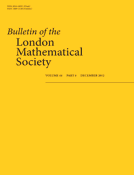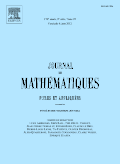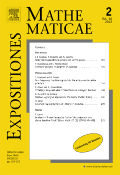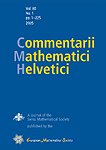
REVUE ROUMAINE DE MATHEMATIQUES PURES ET APPLIQUEES
Scope & Guideline
Innovating in Pure and Applied Mathematics
Introduction
Aims and Scopes
- Algebraic Geometry and Topology:
The journal frequently publishes research focused on algebraic and symplectic geometry, including studies on curves, varieties, and complex structures, highlighting innovative approaches to classical problems. - Functional Analysis and Operator Theory:
There is a strong emphasis on functional analysis, particularly in relation to operators and their applications, which is evident in papers discussing spectral theory and integral operators. - Mathematical Physics and Applications:
Research intersecting mathematics and physics, including topics like stochastic processes, random walks, and integrable systems, showcases the journal's dedication to applied mathematics. - Geometry and Differential Equations:
A significant amount of content is devoted to differential geometry and its connections with partial differential equations, exploring geometric structures and their analytical properties. - Combinatorial and Number Theory:
The journal includes works on combinatorial mathematics and number theory, emphasizing the interplay between these fields and other mathematical disciplines.
Trending and Emerging
- Homological and Cohomological Methods:
There is an increasing trend in utilizing homological and cohomological techniques, particularly in algebraic geometry and topology, indicating a shift towards deeper structural analysis. - Stochastic Processes and Random Analysis:
Research on stochastic processes, including their mathematical foundations and applications, has gained momentum, reflecting the relevance of randomness in modern mathematical modeling. - Geometric Analysis and Nonlinear PDEs:
Emerging themes in geometric analysis, particularly in the study of nonlinear partial differential equations, showcase the interplay between geometry and analysis in tackling complex mathematical challenges. - Applications of Algebraic Structures:
A notable increase in papers discussing the applications of algebraic structures in various fields, such as physics and data science, highlights the interdisciplinary nature of current mathematical research.
Declining or Waning
- Classical Analysis:
The journal has seen a reduction in papers focused on classical analysis, particularly in areas such as traditional real analysis and elementary function theory, as more advanced topics gain traction. - Elementary Group Theory:
Research contributions related to elementary group theory have been less frequent, suggesting that this area may be losing prominence in favor of more complex algebraic structures and their applications. - Basic Combinatorial Techniques:
There is a noticeable decline in papers utilizing basic combinatorial techniques, which may indicate a shift toward more sophisticated combinatorial methods or interdisciplinary approaches. - Historical Mathematical Studies:
Papers reflecting on historical mathematical developments or figures seem to be waning, possibly due to a growing focus on contemporary research and applications.
Similar Journals

BULLETIN OF THE LONDON MATHEMATICAL SOCIETY
Championing Scholarly Discourse in the Mathematical SciencesThe BULLETIN OF THE LONDON MATHEMATICAL SOCIETY, published by Wiley, is a distinguished journal that serves as a vital resource in the field of mathematics. With its ISSN 0024-6093 and E-ISSN 1469-2120, this journal has consistently provided a platform for innovative research and scholarly discourse since its inception in 1969. Recognized for its quality, it currently holds an impressive Q1 ranking in the mathematics category, a testament to its significance in disseminating influential findings and trends in the mathematical sciences. Researchers and practitioners can rely on the BULLETIN for its comprehensive coverage of both theoretical and applied mathematics, which caters to a diverse audience ranging from professionals to students alike. Though it does not currently offer Open Access options, its articles can be accessed through institutional subscriptions, ensuring that significant works reach the academic community effectively. With contributions that span over five decades, the journal continues to shape mathematical research and inspire future advancements in the discipline.

JOURNAL DE MATHEMATIQUES PURES ET APPLIQUEES
Exploring Pure and Applied InsightsJOURNAL DE MATHEMATIQUES PURES ET APPLIQUEES, published by Elsevier, serves as a pivotal resource for scholars and practitioners in the field of mathematics. With an ISSN of 0021-7824 and E-ISSN of 1776-3371, this esteemed journal is at the forefront of disseminating crucial research from 1997 to 2024. It is recognized for its prestigious Q1 rankings in both Applied Mathematics and Miscellaneous Mathematics categories in 2023, highlighting its significant influence in these domains. It holds impressive Scopus ranks—35th out of 399 in General Mathematics and 126th out of 635 in Applied Mathematics, placing it within the top percentiles of academic publications. Although it does not currently offer open access options, the journal's commitment to high-quality, peer-reviewed research ensures that it remains a crucial asset for ongoing developments in mathematical theory and application. Notably, with its headquarters in Amsterdam, the journal attracts a global readership eager to explore the latest advancements and applications in mathematics.

EXPOSITIONES MATHEMATICAE
Fostering Original Research in Diverse Mathematical FieldsEXPOSITIONES MATHEMATICAE, published by Elsevier GmbH, stands as a significant journal in the realm of mathematics, catering primarily to researchers, professionals, and students. With an ISSN of 0723-0869 and an E-ISSN of 1878-0792, this journal has made its mark in the academic community, boasting a Q2 classification in the miscellaneous mathematics category for 2023, illustrating its prominence within its field. The journal addresses a diverse scope of mathematical topics, encouraging the publication of original research and innovative theories while maintaining rigorous academic standards. As it converges from 2004 to 2024, EXPOSITIONES MATHEMATICAE continues to be an essential resource for advancing mathematical knowledge and fostering scholarly communication, despite being a non-open-access publication. Its location in Munich, Germany further anchors it within a rich intellectual tradition, providing accessibility for the mathematical community worldwide.

COMMENTARII MATHEMATICI HELVETICI
Advancing Mathematical Frontiers with Open Access InsightsCOMMENTARII MATHEMATICI HELVETICI, published by the EUROPEAN MATHEMATICAL SOCIETY, is a premier open-access journal in the field of mathematics, specifically categorized within the Q1 quartile of miscellaneous mathematics as of 2023. With an ISSN of 0010-2571 and an E-ISSN of 1420-8946, this esteemed journal has a rich history, having commenced its publication journey in 1929 and set to continue until at least 2024. Based in Germany, it provides a valuable platform for original research and significant advancement in mathematical theory and application, appealing to researchers, professionals, and students alike. The journal's commitment to open access since 2022 further enhances its accessibility and outreach, ensuring that cutting-edge mathematical developments are readily available to a global audience. Its Scopus ranking, which places it at the 165th position out of 399 in the general mathematics category (58th percentile), exemplifies its impact and relevance in the academic community.

Rendiconti del Circolo Matematico di Palermo
Navigating the Evolution of Mathematical Ideas.Rendiconti del Circolo Matematico di Palermo, published by SPRINGER-VERLAG ITALIA SRL, is a revered journal in the field of mathematics, emphasizing the cultivation and dissemination of mathematical knowledge since its inception in 1887. With its ISSN 0009-725X and E-ISSN 1973-4409, this esteemed publication has continued to thrive, showcasing innovative research, comprehensive reviews, and thoughtful discussions from diverse areas in mathematics, particularly in its Q2 ranking within the miscellaneous mathematics category. Its historical significance is underscored by its convergence of publications across numerous years, including its notable periods from 1887 to 1916, 1919 to 1938, and beyond, effectively capturing the evolution of mathematical thought. Though not open access, the journal remains an essential resource for researchers, professionals, and students aiming to stay updated with the latest advancements and methodologies in the ever-evolving landscape of mathematics. With its Scopus rank placing it in the top 25th percentile, Rendiconti del Circolo Matematico di Palermo continues to be a cornerstone for scholarly dialogue and development in its domain.

Analele Stiintifice ale Universitatii Ovidius Constanta-Seria Matematica
Navigating the Future of Mathematics with Rigorous ScholarshipAnalele Stiintifice ale Universitatii Ovidius Constanta-Seria Matematica is a prominent open-access journal established by OVIDIUS UNIV PRESS in Romania, dedicated to advancing the fields of mathematics, specifically in Analysis and Applied Mathematics. Since its inception, the journal has emphasized the dissemination of high-quality research, making it accessible to a global audience. With an ISSN of 1224-1784 and E-ISSN 1844-0835, it has positioned itself within the academic community, achieving a respectable Q3 ranking in both analysis and applied mathematics in 2023, reflecting its commitment to rigorous scholarship. The journal spans a considerable publication window from 2009 to 2024, catering to the ongoing developments in mathematical sciences and their applications. Researchers, professionals, and students alike will find valuable insights and contributions that enrich their understanding and foster collaboration within the mathematical community. The journal's headquarters is based at the Faculty of Mathematics & Computer Science, Bulevardul Mamaia 124, Constanta, Romania.

PUBLICATIONES MATHEMATICAE DEBRECEN
Bridging Theory and Application in MathematicsPublicationes Mathematicae Debrecen is a renowned international journal published by the University of Debrecen, Institute of Mathematics, situated in Hungary. This journal, with both ISSN 0033-3883 and E-ISSN 2064-2849, has established itself in the field of mathematics since its inception, with coverage extending from 1997 to 2024. Recognized for its rigorous academic standards, it currently holds a Q3 ranking in the mathematics (miscellaneous) category for 2023 and ranks at the 42nd percentile among general mathematics journals in Scopus. Publicationes Mathematicae Debrecen aims to disseminate high-quality research across various areas of mathematics, contributing to the advancement of knowledge and practice in this dynamic field. Although it is not an open-access journal, its readers can access a wealth of scholarly work that addresses both theoretical and applied mathematical issues, making it an invaluable resource for researchers, professionals, and students alike.

European Journal of Mathematics
Advancing Mathematical FrontiersWelcome to the European Journal of Mathematics, a prominent publication that serves as a vital platform for disseminating high-quality research in the field of mathematics. Published by Springer International Publishing AG, this journal has witnessed significant growth since its inception in 2015 and is recognized for its contributions within the Q2 category of Mathematics (miscellaneous) as per the 2023 rankings. With an ISSN of 2199-675X and an E-ISSN of 2199-6768, the journal aims to foster innovation and collaboration among researchers, professionals, and students alike. Although it operates under a traditional access model, the journal's commitment to advancing mathematical knowledge and applications cannot be overstated. Positioned among the top-tier publications, the European Journal of Mathematics is an essential resource that encourages the exploration of emerging trends and theories in mathematics, making it indispensable for anyone striving to stay at the forefront of this dynamic field.

ACTA MATHEMATICA
Advancing Mathematical Excellence Since 1882ACTA MATHEMATICA, published by INT PRESS BOSTON, INC, stands as a prestigious journal in the field of mathematics, holding a distinguished Q1 ranking in the miscellaneous mathematics category for 2023. With a storied history dating back to its inception in 1882, this journal serves as a vital platform for researchers, professionals, and students to disseminate and exchange groundbreaking mathematical theories and applications. Although it is not an open-access journal, it remains influential within the academic community, contributing significantly to the advancement of mathematical knowledge and research integrity. Located in the Netherlands, ACTA MATHEMATICA continues to thrive, bridging historical mathematical discourse with contemporary innovation. Researchers and scholars are encouraged to engage with this venerable publication to stay abreast of emerging trends and discoveries in the mathematical sciences.

TRANSACTIONS OF THE AMERICAN MATHEMATICAL SOCIETY
Championing Excellence in Mathematical ResearchTRANSACTIONS OF THE AMERICAN MATHEMATICAL SOCIETY, published by the American Mathematical Society, is a premier journal in the field of mathematics that has been contributing to the advancement of mathematical knowledge since 1900. With an ISSN of 0002-9947 and an E-ISSN of 1088-6850, this journal holds a prestigious position in the academic landscape, evidenced by its Q1 rankings in both Applied Mathematics and Miscellaneous Mathematics categories as of 2023. With a Scopus ranking of #97 in General Mathematics and a percentile standing of 75th, the journal is recognized for its rigorous peer-review process and the quality of the research it publishes. Though it does not currently offer open access options, it essentially serves as a vital resource for researchers, professionals, and students seeking critical insights and developments in mathematical theory and applications. The Transactions aim to publish high-quality research articles that foster the exchange and dissemination of ideas, supporting the growth of both theoretical and applied mathematics within the global scholarly community.